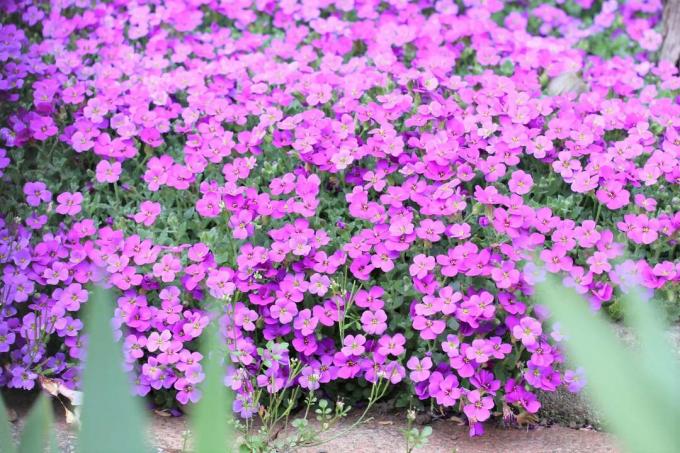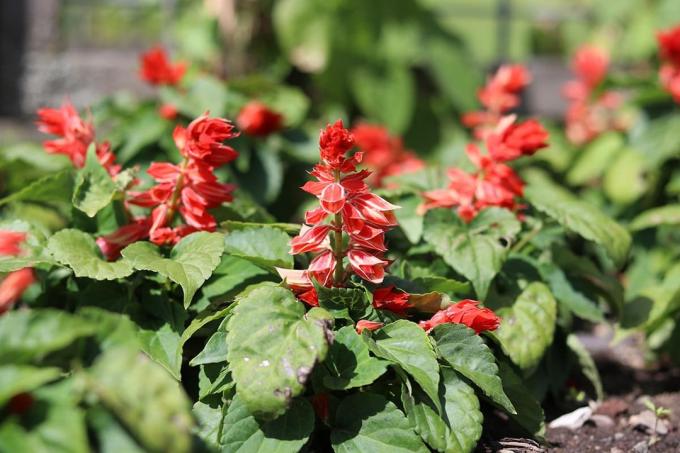

Table of contents
- planting time
- Care, cutting and propagation
- Location
- Tips for pruning
- Blue Cushion - a popular upholstery perennial
- Characteristics
Despite its name, the cushion perennial not only flowers in blue, it also shines in white, pink, purple and red. Beautiful combinations can be created as accompanying plants in the rock garden with goose cress, alyssum, cushion phlox and cushion soapwort. Blue cushions are the first nectar source of the year for bees and other insects.
planting time
The best planting time for the blue cushions is spring or autumn. If you want to green a larger area, the ideal distance between the individual plants is about 20 to 30 centimeters, so about eight to ten plants are needed per square meter. When these plants have formed a closed carpet, they suppress weeds, making such a bed very easy to care for. This carpet gets bigger and bigger over the years and also stays in winter, because the blue cushion belongs to the evergreen plants.
Care, cutting and propagation
Blue cushions thrive best in nutrient, chalky soil that is loose and well-drained. If you plant them on the top of a wall, you have to make sure that there is always enough soil, otherwise the growth will be poor and the plants will bare from below. This is also the case in shady locations. Fertilize in early spring before flowering with compost or natural fertilizer, but sparingly, because too much fertilizer reduces winter hardiness.
As a rule, blue pillows do not need winter protection, only in extreme cold periods without snow you can cover them with some brushwood. They are also frugal when watering. But if it is dry for a long time, you should water the blue cushions, otherwise the cushions will turn yellow. Diseases and pests are extremely rare on these plants, except for the snails, who love the delicate shoot tips.
After flowering, the cushion perennials must be cut back heavily, this promotes growth and flowering. Sometimes in the summer there is a second, but much weaker bloom. If you want to limit the growth of the blue cushions, you can simply cut off or stab parts of the plant along the edge. Some varieties can be grown from seed. However, it is easier to propagate with cuttings, which can be done all year round. To do this, after flowering, small parts of the main plant are cut off and placed individually in pots.
In autumn or in the early spring that follows, the young blue cushion plants are then used in their final places. Blue cushions planted in autumn still grow well and flower more profusely in spring because they do not have "translocation shock". The seedlings can also be planted out on the spot, but they should initially be protected from too much sunlight. Before planting, you have to loosen the soil well and work in compost or fertilizer. In addition, the floor should be free of weeds, as it will later be difficult to remove them from between the cushions. Blue pillows are frugal. With little care, they delight us every year with their lush carpets of flowers.
Location
Blue cushions should get a place that is as sunny as possible, because their home is in the Mediterranean region. They are best planted in a rock garden or on a dry stone wall, as they do better in dry soil than in a spot that is too wet. For this reason, they only need to be additionally watered in particularly dry times. You should also be extremely economical with fertilizers for these plants, because too much fertilizer can definitely damage them.
Tips for pruning
In order for the plant to grow compactly and produce many flowers again the following year, it needs pruning, which should preferably be done immediately after the flowering period. The shoots of the plant can be shortened by half. In general, this pruning is not absolutely necessary. However, removing the faded flowers in late summer or fall may result in a second bloom. This also has the advantage that the plants in the lower area do not bare so easily. Dead plant parts should be removed in any case, so that the plants do not waste energy unnecessarily.
Blue Cushion - a popular upholstery perennial
The original homeland of the blue cushions is Sicily, the Balkans, Greece and Asia Minor. Therefore, they love a warm, sunny location. The botanical name of the plant is Aubrieta from the cruciferous family. Blue cushions are low, perennial and hardy plants. As typical cushion perennials, they are suitable for rock gardens, wall crowns, joints on steps and slabs, but also look beautiful in window boxes, as bed borders and in planters. The approximately 10 cm high cushions of grey-green leaves disappear almost completely under the carpet of flowers during the flowering period from April to May. Over the years, countless color and flower variants have emerged. Well-known and flowering varieties are:
- Aubrieta "Blaumeise", fast-growing, blue-violet flowers
- Aubrieta "Hürth", lush cushions, flower color light blue
- Aubrieta 'Hamburger Stadtpark', dense cushions, small deep blue-violet flowers
- Aubrieta "Kitty", large-flowered variety, purple-blue flowers
- Aubrieta "Dr. Mules", good growth traits, flower color reddish-purple
- Aubrieta 'Downers Bont', white variegated foliage, flower color dark purple
- Aubrieta 'Ruby Fire', striking variety with ruby red flowers
- Aubrieta 'Winterling', dense cushions of small, white flowers
- `Aurea`, syn. `Aurea Variegata` has gold-edged leaves and purple flowers.
- `Dr. Mules` impresses with a violet-red blossom splendor.
- `Wanda` produces double, red flowers.
- `Alba` produces white flowers.
Characteristics
- Height 7.5-10cm
- Planting distance 4.5 - 60 cm
- Flowering time from spring to early summer
- Well-drained, preferably alkaline garden soil
- Sunny location
- hardy
Blue cushions are a popular jewelry for rockeries and discounts. However, they unfold their most beautiful splendor when they can proliferate on dry stone walls.
The plant forms hanging or cushion-shaped cushions in different shades of green. In some varieties, the foliage is variegated golden yellow or white. Small purple, pink, white or reddish cruciferous flowers appear from early spring through early summer.
 garden editorial
garden editorial I write about everything that interests me in my garden.
Learn more about perennials

20 hardy plants that bloom all year round
With plants that flower all year round, you can quickly create an attractive garden that does not require much maintenance, as long as the plants are also hardy. In this post, we will introduce you to 20 plants that are suitable for this.

17 flowering hardy plants May to October
Many plants only show their full splendor for a short time. But there are also types and varieties with a particularly long flowering period from May to October, sometimes even longer. We present 17 flowering hardy plants.

Hardy perennials: 22 perennial bloomers
Hardy perennials as permanent bloomers in the flower bed enchant the garden from early summer to autumn with a colorful bloom. They are easy to care for and magically attract butterflies, bees and the like.

10 care tips for the banana tree
If you like it exotic, cultivate a banana tree as a houseplant or in the conservatory. In summer, the banana plants are even allowed outside for a few weeks. The large leaves that the Musa forms on a false trunk are particularly decorative and impressive, and therefore look like a small tree.

Properly care for globe thistle | 10 tips for care
The globe thistle is an eye-catcher in the garden. Their spherical flowers provide a food source for insects. The globe thistle is not difficult to care for and it is suitable for dry locations. With a few tips on care, the plants will develop even better.

Fire sage, Salvia splendens: care from A to Z
Fire sage is known in botanical jargon as Salvia splendens and is a particularly decorative eye-catcher. But what kind of care does the plant need? Our guide to the salvia shows the important points from A to Z.



